Rice cooker recipes open up a world of culinary possibilities, transforming this simple appliance into a versatile kitchen essential. From fluffy white rice to flavorful curries, a rice cooker allows you to create a variety of dishes with minimal effort and maximum deliciousness.
Whether you’re a seasoned chef or a novice cook, the convenience and ease of rice cookers make them a perfect choice for busy weeknights or weekend gatherings.
This guide delves into the basics of rice cookers, exploring their different types, advantages, and maintenance tips. We’ll then guide you through mastering the art of rice cooking, covering rice selection, water ratios, and various cooking methods. Get ready to be inspired by a collection of classic and innovative rice cooker recipes, including those that go beyond rice, utilizing the steaming function and transforming your rice cooker into a multi-functional kitchen hero.
Rice Cooker Basics
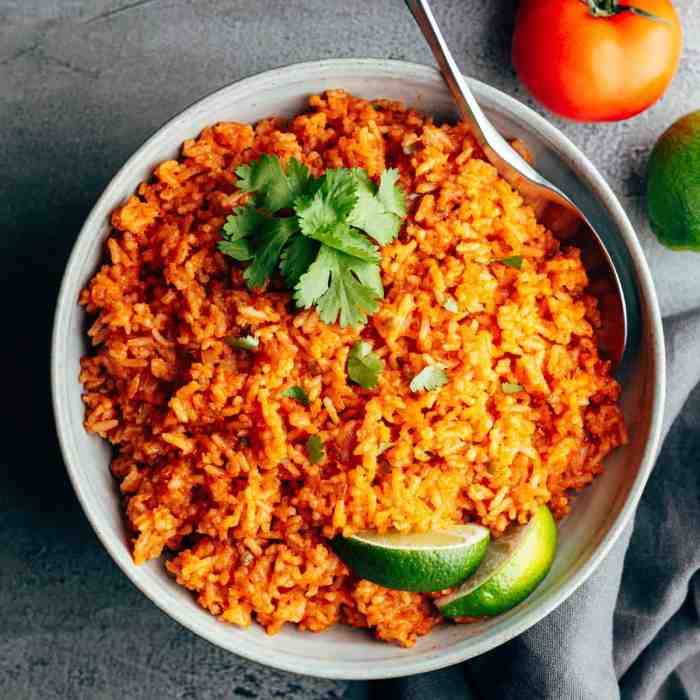
Rice cookers have become an indispensable kitchen appliance for many, offering a simple and efficient way to prepare perfectly cooked rice. They come in various models, each with its own set of features and functionalities. Understanding the different types of rice cookers and their advantages and disadvantages can help you choose the best one for your needs.
Types of Rice Cookers
Rice cookers come in various designs and functionalities, catering to different needs and preferences. Here are some common types:
- Basic Rice Cooker:This is the most basic type, designed for cooking white rice. It typically has a simple design with a single cooking mode.
- Multi-Cooker:These rice cookers offer multiple cooking modes, allowing you to prepare various dishes like porridge, soup, and even steamed vegetables, in addition to rice.
- Fuzzy Logic Rice Cooker:This advanced type utilizes fuzzy logic technology to adjust cooking time and temperature based on the type of rice and the amount being cooked. This ensures consistent and optimal cooking results.
- Pressure Rice Cooker:These cookers use pressure to cook rice faster than traditional methods, resulting in a more flavorful and tender rice. They also offer a variety of cooking modes for other dishes.
- Induction Rice Cooker:Induction rice cookers utilize electromagnetic induction to heat the pot directly, providing precise temperature control and faster cooking times.
Advantages of Using a Rice Cooker
Rice cookers offer several advantages over traditional methods of cooking rice.
- Convenience:Rice cookers are incredibly convenient, requiring minimal effort to operate. Simply add rice, water, and press a button. The appliance does the rest, allowing you to focus on other tasks.
- Consistent Results:Rice cookers ensure consistent results every time, eliminating the risk of overcooked or undercooked rice. They automatically adjust cooking time and temperature based on the type of rice and amount being cooked.
- Time-Saving:Rice cookers save time by automating the cooking process. You can set it and forget it, allowing you to use the time for other activities.
- Versatility:Many modern rice cookers offer multiple cooking modes, allowing you to prepare various dishes beyond just rice. They can be used for cooking porridge, soup, and even steaming vegetables.
- Energy Efficiency:Rice cookers are generally energy-efficient, using less energy than traditional methods of cooking rice. This can save you money on your electricity bills.
Disadvantages of Using a Rice Cooker
While rice cookers offer many advantages, they also have some drawbacks.
- Cost:Rice cookers can be expensive, especially those with advanced features like fuzzy logic or pressure cooking capabilities.
- Limited Capacity:Some rice cookers have a limited capacity, which may not be suitable for large families or frequent entertaining.
- Cleaning:Cleaning a rice cooker can be a bit more time-consuming than cleaning a pot, as it involves removing and washing multiple parts.
- Space:Rice cookers take up counter space, which can be a concern for those with limited kitchen space.
Cleaning and Maintaining a Rice Cooker
Proper cleaning and maintenance are essential for extending the life of your rice cooker and ensuring its optimal performance.
- Unplug the rice cookerand let it cool down completely before cleaning.
- Remove the inner potand wash it with warm, soapy water. Use a non-abrasive sponge or cloth to avoid scratching the surface.
- Clean the lid, steam vent, and other removable parts with warm, soapy water.
- Wipe the exteriorof the rice cooker with a damp cloth. Avoid using harsh cleaners or abrasive materials.
- Dry all partsthoroughly before reassembling the rice cooker.
- Store the rice cookerin a cool, dry place when not in use.
Mastering the Art of Rice Cooking
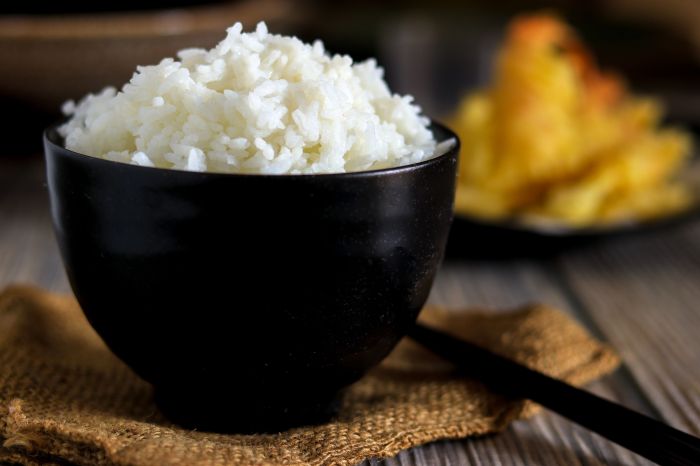
Cooking rice perfectly is a fundamental skill in many cuisines. While rice cookers take the guesswork out of timing and monitoring, understanding the nuances of rice types and cooking methods can elevate your rice game.
Selecting the Right Rice
Choosing the right type of rice is crucial for achieving the desired texture and flavor in your dishes. Different rice varieties have unique characteristics, such as grain size, starch content, and cooking time.
- Short-grain rice, with its high starch content, produces a sticky, soft rice ideal for sushi, rice balls, and rice pudding. Examples include Japanese short-grain rice and Arborio rice, used for risotto.
- Medium-grain riceoffers a balance of stickiness and fluffiness, making it versatile for various dishes like fried rice, stir-fries, and rice bowls. Popular examples include Jasmine rice and Basmati rice.
- Long-grain rice, with its low starch content, cooks up fluffy and separate, perfect for pilafs, side dishes, and salads. Examples include Thai jasmine rice and brown rice.
Rice to Water Ratio
The ideal ratio of rice to water is essential for achieving the perfect consistency. This ratio varies depending on the type of rice and the desired outcome.
- Short-grain ricetypically requires a 1:1 ratio of rice to water, resulting in a sticky texture.
- Medium-grain ricegenerally uses a 1:1.25 ratio of rice to water, producing a slightly less sticky result.
- Long-grain riceoften requires a 1:1.5 ratio of rice to water, resulting in fluffy, separate grains.
Rice Cooking Methods
While rice cookers excel in convenience, exploring other cooking methods can add depth and versatility to your rice dishes.
Steaming
Steaming rice is a gentle cooking method that preserves its natural flavors and nutrients. It involves placing rice in a steamer basket over boiling water, allowing the steam to cook the rice evenly. This method is ideal for long-grain rice, resulting in fluffy and flavorful grains.
Pressure Cooking
Pressure cooking is a quick and efficient method for cooking rice. It uses high pressure and steam to cook rice in a shorter time than traditional methods. This method is suitable for all rice types, producing tender and flavorful results.
Slow Cooking
Slow cooking is a low-and-slow method that yields tender and flavorful rice. It involves cooking rice in a slow cooker with a specific ratio of water. This method is particularly well-suited for brown rice, which requires longer cooking times.
Discover how tips memilih jurusan kuliah has transformed methods in this topic.
Rice Cooker Recipe Inspiration: Rice Cooker Recipes
Your rice cooker is a versatile kitchen tool that can do more than just cook rice. It can be used to create a wide variety of dishes, from savory main courses to sweet desserts. With a little creativity, you can use your rice cooker to make delicious and healthy meals without spending hours in the kitchen.
Classic Rice Cooker Recipes
Here are some classic rice cooker recipes that are perfect for beginners:
- White Rice:White rice is the most basic rice cooker recipe. Simply rinse the rice, add water according to the manufacturer’s instructions, and press start.
- Brown Rice:Brown rice takes longer to cook than white rice, but it’s a healthier option. Rinse the rice, add water, and cook according to the manufacturer’s instructions. You may need to add more water than for white rice.
- Sticky Rice:Sticky rice is a popular ingredient in Asian cuisine. It’s often used in sushi and other dishes. Rinse the rice, add water, and cook according to the manufacturer’s instructions. Sticky rice will be soft and slightly sticky when cooked.
Rice Cooker Recipes by Cuisine
Rice cookers are popular in many cuisines around the world. Here are some rice cooker recipes inspired by different cuisines:
| Cuisine | Recipe | Description |
|---|---|---|
| Asian | Fried Rice | A classic Asian dish that is easy to make in a rice cooker. Combine cooked rice with vegetables, meat, and eggs, and stir-fry in the rice cooker. |
| Mediterranean | Rice Pilaf | A flavorful rice dish that is often served with Middle Eastern and Mediterranean dishes. Combine rice with vegetables, herbs, and spices, and cook in the rice cooker. |
| Latin American | Arroz con Leche | A sweet rice pudding that is popular in Latin America. Combine rice with milk, sugar, and spices, and cook in the rice cooker. |
Rice Cooker Recipes with Different Cooking Techniques
Rice cookers can be used to cook rice in a variety of ways. Here are some rice cooker recipes that utilize different cooking techniques:
| Technique | Recipe | Description |
|---|---|---|
| Stir-frying | Rice Cooker Stir-fry | A quick and easy way to cook a stir-fry in a rice cooker. Combine vegetables, meat, and sauce in the rice cooker, and stir-fry until cooked. |
| Baking | Rice Cooker Baked Chicken | A simple and flavorful way to cook chicken in a rice cooker. Place chicken in the rice cooker, add vegetables and sauce, and bake until cooked. |
Rice Cooker Beyond Rice
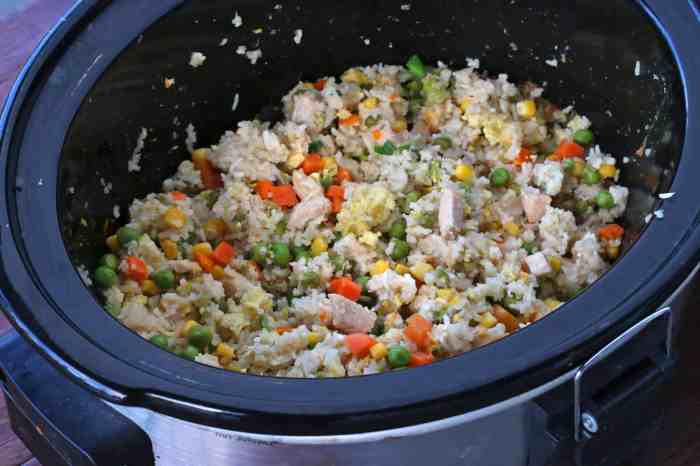
Your trusty rice cooker isn’t just for rice! It’s a versatile kitchen appliance capable of preparing a variety of dishes, from hearty soups to comforting desserts. Beyond its primary function, a rice cooker can be used for steaming, slow cooking, and even baking, making it a valuable tool for any home cook.
Exploring the Rice Cooker’s Versatility
The rice cooker’s versatility stems from its ability to maintain a consistent temperature, making it ideal for cooking various foods without overcooking or burning. Its steaming function is particularly useful for preparing delicate foods like fish, vegetables, and dumplings.
The rice cooker’s slow cooking capability allows you to prepare hearty stews and soups, while its ability to maintain a constant temperature is perfect for baking cakes and other desserts.
Rice Cooker Recipes for Steaming
Steaming is a healthy cooking method that preserves nutrients and flavor. A rice cooker’s steaming function is perfect for preparing vegetables, fish, and dumplings. Here are a few recipes to get you started:
- Steamed Vegetables: Simply place your favorite vegetables, such as broccoli, carrots, or asparagus, in the steaming basket and cook according to the rice cooker’s instructions. Season with salt and pepper to taste.
- Steamed Fish: Season a whole fish or fish fillets with salt, pepper, and your favorite herbs and spices. Place the fish in the steaming basket and cook until it’s flaky and cooked through.
- Steamed Dumplings: Place your favorite dumplings in the steaming basket and cook until they’re translucent and cooked through. Serve with a dipping sauce of your choice.
Make-Ahead Rice Cooker Recipes
Rice cooker recipes can be made ahead of time and reheated for convenient meal prep. This is especially helpful for busy weeknights when you need a quick and easy meal. Here are a few recipes that are perfect for make-ahead meal prep:
- Chicken and Rice Casserole: This hearty casserole can be made ahead of time and reheated in the rice cooker. It’s a great option for a quick and easy weeknight dinner.
- Slow Cooker Chili: This classic chili can be made in the rice cooker and reheated for a comforting and satisfying meal.
- Rice Pudding: This creamy dessert can be made ahead of time and reheated in the rice cooker. It’s a perfect option for a sweet treat or a light breakfast.
Rice Cooker Tips and Tricks
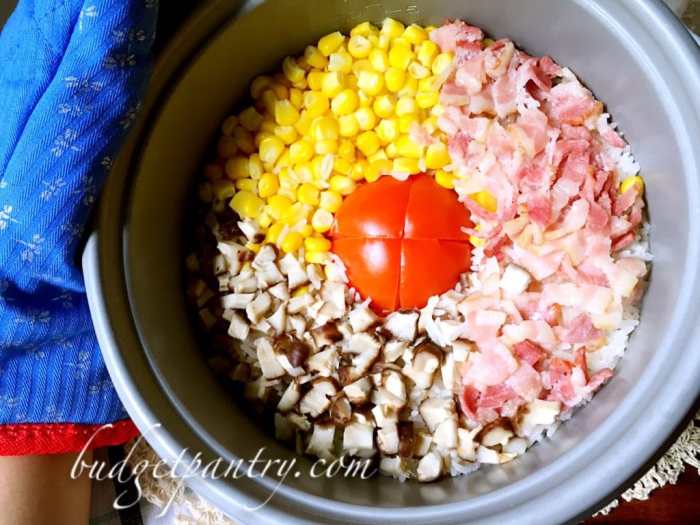
Rice cookers are incredibly convenient appliances, but even the simplest devices can sometimes lead to less-than-perfect results. Understanding common mistakes and mastering a few key tricks can help you achieve consistently delicious rice every time.
Troubleshooting Common Rice Cooker Mistakes
Troubleshooting common rice cooker mistakes can save you time and frustration.
- Undercooked Rice:This is often caused by using too much water or not allowing the rice to cook long enough. The solution is to use the correct water-to-rice ratio for your specific rice type and allow the rice cooker to complete the entire cooking cycle, including the “keep warm” phase.
- Overcooked Rice:This can happen if you use too little water or let the rice cook for too long. The fix is to carefully measure the water and rice, and avoid leaving the rice in the “keep warm” mode for extended periods.
- Burnt Rice:This usually occurs when the rice sticks to the bottom of the inner pot. To prevent this, make sure to use enough water, stir the rice occasionally during cooking, and use a non-stick inner pot.
- Unevenly Cooked Rice:This can be caused by overcrowding the inner pot or using a rice cooker that isn’t large enough for the amount of rice you’re cooking. The solution is to use a rice cooker that’s the right size for your needs and avoid overfilling the inner pot.
Using Rice Cooker Accessories, Rice cooker recipes
Rice cooker accessories can significantly enhance your cooking experience and expand the range of dishes you can prepare.
- Steaming Baskets:Steaming baskets are versatile accessories that allow you to cook vegetables, fish, and other foods simultaneously with your rice. This is a great way to create healthy and flavorful meals in one pot.
- Inner Pots:Some rice cookers come with multiple inner pots, each designed for a specific type of rice or cooking method. For example, a non-stick inner pot is ideal for sticky rice, while a clay pot can help achieve a more authentic flavor and texture.
Flavor and Texture Enhancement Techniques
Here are some simple techniques to elevate the flavor and texture of your rice:
- Adding Flavorings:Incorporate spices, herbs, or aromatics directly into the rice while cooking. For example, adding a bay leaf, cinnamon stick, or star anise can infuse the rice with a subtle fragrance. You can also use ginger, garlic, onions, or even a splash of soy sauce for added depth of flavor.
- Adjusting Cooking Time:Experiment with different cooking times to achieve your desired texture. For example, slightly reducing the cooking time can result in firmer rice, while extending the time can create a softer, more mushy texture.
- Rinsing Rice:Rinsing rice before cooking helps remove excess starch, resulting in fluffier, less sticky rice. Gently rinse the rice in a fine-mesh strainer until the water runs clear.
- Using Different Rice Types:Explore different rice varieties to experience a range of flavors and textures. Short-grain rice, like Japanese rice, is known for its stickiness and is ideal for sushi. Long-grain rice, like basmati rice, is fluffy and aromatic.
Conclusive Thoughts
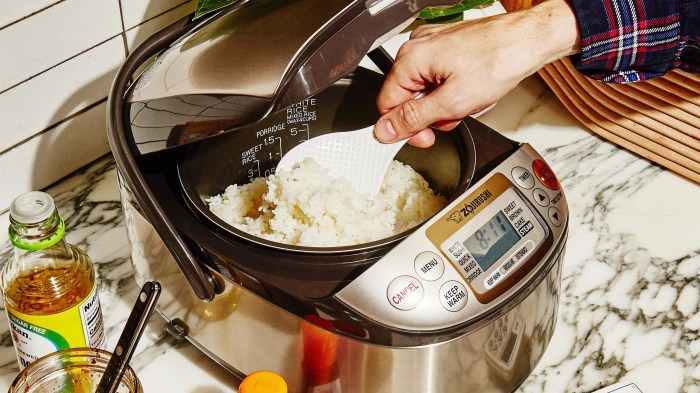
With a rice cooker, the possibilities are truly endless. Embrace the simplicity and versatility of this kitchen companion to create a symphony of flavors and textures. From traditional comfort food to exciting global cuisines, your rice cooker becomes a gateway to a world of culinary adventures.
So, let your imagination run wild and discover the joy of cooking with a rice cooker, where delicious meals are just a push of a button away.
